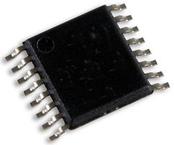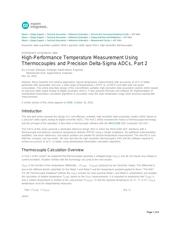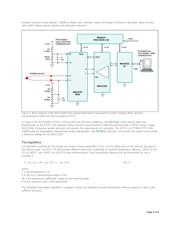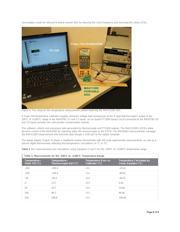herunterladen

Maxim > Design Support > Technical Documents > Reference Schematics > A/D and D/A Conversion/Sampling Circuits > APP 5684
Maxim > Design Support > Technical Documents > Reference Schematics > Analog Switches and Multiplexers > APP 5684
Maxim > Design Support > Technical Documents > Reference Schematics > Measurement Circuits > APP 5684
Keywords: data-acquisition systems (DAS), precision delta-sigma ADCs, high-resolution thermocouples
REFERENCE SCHEMATIC 5684
High-Performance Temperature Measurement Using
Thermocouples and Precision Delta-Sigma ADCs, Part 2
By: Joseph Shtargot, Strategic Applications Engineer
Mohammad Qazi, Applications Engineer
Nov 22, 2013
Abstract:
Many industrial
and medical applications require temperature measurements with accuracies of ±1°C or better,
performed with reasonable cost over a wide range of temperatures (-270°C to +1750°C) and often with low power
consumption. This article describes design of the cost-efficient, portable, high-resolution data-acquisition systems (DAS) based
on precision delta-sigma analog-to-digital converters (ADCs). It also presents formulas and software for implementation of
standardized linearization calculation algorithms to accurately cover this wide temperature range while ensuring reproducible
measurements.
A similar version of this article appears on EDN, October 18, 2013.
Introduction
This two-part series presents the design of a cost-effective, portable, high-resolution data-acquisition system (DAS) based on
a precision delta-sigma analog-to-digital converter (ADC). The Part 1 article reviewed the history of thermocouple technology
and the principal of the operation. It described a thermocouple interface with the MAX11200 ADC evaluation (EV) kit.
1
This Part 2 of the series presents a dedicated reference design (RD) in which the MAX11200 ADC interfaces with a
thermocouple and platinum resistance temperature detector (PRTD) using a simple multiplexor. No additional instrumentation
amplifiers, low-noise references, and optical isolation are needed for precise temperature measurement. The new RD is cost
effective, compact, and low power. We also describe the high-resolution thermocouple’s DAS and the software required to
achieve accuracies of ±1°C, or better, using standardized linearization calculation algorithms.
Thermocouple Calculation Overview
In Part 1 of this series
2
we explained that thermocouples generate a voltage/charge (V
OUT
) and do not require any voltage or
current excitation. Readers familiar with the technology can jump to the next section.
V
OUT
is the function of the temperature differential, - (T
JUNC
- T
COLD
), produced by two dissimilar metals. The differential is
due to the different electric potentials for the Metal 1 and Metal 2 and the temperature gradient applied to them.
3
The NIST
ITS-90 Thermocouple Database
4
defines this V
OUT
function for most practical Metal 1 and Metal 2 combinations and enables
the calculation of relative temperature T
JUNC
based on the V
OUT
measurements. It is important to emphasize that T
JUNC
is
only a relative temperature in relation to the cold junction (T
COLD
). To find the absolute temperature (in °C, °F, or K), T
COLD
temperature must be independently measured:
Tabs = T
JUNC
+ T
COLD
(Eq. 1)
where:
Page 1 of 8
Verzeichnis
- ・ Blockdiagramm on Seite 1 Seite 4 Seite 8
- ・ Anwendungsbereich on Seite 1








